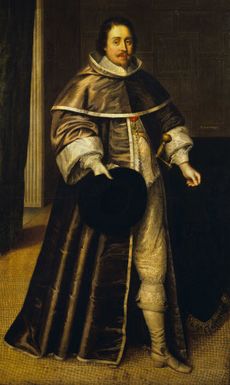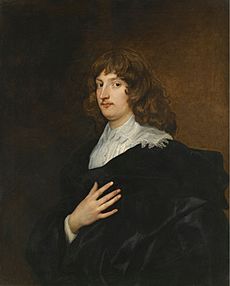Battle of Babylon Hill facts for kids
Quick facts for kids Battle of Babylon Hill |
|||||||
|---|---|---|---|---|---|---|---|
| Part of the First English Civil War | |||||||
|
|||||||
| Belligerents | |||||||
| Commanders and leaders | |||||||
| Strength | |||||||
| c. 350 | c. 350 | ||||||
| Casualties and losses | |||||||
| estimated 15–60 | estimated 3–16 | ||||||
The Battle of Babylon Hill was a small fight that happened on 7 September 1642. It took place near Yeovil in South West England. This battle was between the Royalists (who supported King Charles I) and the Parliamentarians (who supported Parliament). It was an early part of the First English Civil War.
This fight happened after the Parliamentarians tried and failed to capture Sherborne Castle. The castle was held by Royalist forces. After their failed attack, the Parliamentarians went back to Yeovil. The Royalists then sent about 350 soldiers to check on their movements.
This Royalist group was led by Sir Ralph Hopton. They set up on Babylon Hill, just outside Yeovil. As evening came, the Royalists started to leave the hill. But then they saw Parliamentarian soldiers coming. Sir Ralph Hopton quickly called his soldiers back to get ready for a fight.
The battle was quite messy because many soldiers on both sides were new to fighting. The Parliamentarians also had about 350 soldiers. They attacked with their cavalry (soldiers on horseback) from three different directions. The Royalists managed to push them back. Parts of both armies ended up running away in confusion. As it got dark, both sides managed to pull back.
Neither side lost many soldiers. Both sides later claimed they had killed sixty or more enemies. But today, experts think the Royalists lost about twenty men. The Parliamentarians probably lost around five. After the battle, the Parliamentarians moved from Yeovil to Dorchester. About two weeks later, the Royalists also left the area completely.
Contents
Why Did the Battle of Babylon Hill Happen?
Tensions between the Parliament and King Charles I grew very strong in 1642. This happened after the King tried to arrest five members of Parliament. The King then chose the Marquess of Hertford to lead his forces in the West Country. Sir Ralph Hopton, a local Member of Parliament and an experienced officer, helped him.
The county of Somerset mostly supported Parliament, not the King. So, when the Royalists set up camp in Wells, they were often in danger. They won a small fight at Marshall's Elm. Their better cavalry and leaders helped them beat a much larger Parliamentarian force.
But the Royalists had to leave Wells on 6 August. The local people rose up against them, even using farm tools as weapons. Hertford and his men went to Sherborne in Dorset. He put nearly 1,500 soldiers in the castle. Dorset was split in its support. Most big towns liked Parliament, but rural areas and the north of the county supported the Royalists.
A Parliamentarian army of 3,500 to 7,000 soldiers attacked Sherborne on 2 September 1642. This army was led by William Russell, 5th Earl of Bedford. On the first day, the Royalists did well in some small fights in the town. But they could not stop the Parliamentarians from firing cannons at the town and castle.
Sir Ralph Hopton led his dragoons (soldiers who rode horses but fought on foot) in small raids at night. They attacked the enemy camp. The Royalists also fired their own cannons back at the Parliamentarian army. The Parliamentarian army was not very experienced. Many soldiers ran away, especially on the night of 5/6 September, when about 800 left.
Bedford's army shrank to only 1,200 to 1,500 soldiers. So, he pulled his army back to Yeovil. A small group of Royalist skirmishers led by Hopton followed them.
Getting Ready for Battle at Babylon Hill
The day after the attack on Sherborne Castle ended, Hertford sent Sir Ralph Hopton. Hopton had about 350 men. This included 150 horsemen (both cavalry and dragoons) and 200 foot soldiers. Their job was to scout (check out) what the enemy was doing in Yeovil.
As they got close to Yeovil, Hopton set up his men on Babylon Hill. He thought it was a good place to watch the town. There were paths with hedges that let his soldiers climb the hill without being seen. Hopton was careful about attacks. He placed musketeers (soldiers with muskets) and dragoons along the paths leading to the top. He kept his cavalry and other musketeers at the summit.
Bedford had placed guards, including foot soldiers and cannons, at Yeovil Bridge. This bridge crossed the River Yeo. Hopton's men could see these guards clearly. For over an hour, his musketeers shot at the guards, but it did not do much damage.
The Fight at Babylon Hill
As evening came, Hopton talked with his officers. They decided to go back to Sherborne for the night. At 6:00 PM, about half an hour before sunset, they started to move their foot soldiers off the hill. The cavalry and dragoons stayed behind to protect them.
But before all the foot soldiers had left Babylon Hill, a Royalist officer named Colonel Lawdy saw enemy soldiers coming. They were crossing the fields using a "secret way." Instead of climbing the hill through the paths Hopton had protected, the Parliamentarians went straight through the fields. This way, they avoided Hopton's hidden soldiers. A Parliamentarian report said the Royalists had "six musketeers on each side the way to entertain us, but they missed us all." Hopton remembered having twenty musketeers guarding one path and all his dragoons hidden in hedges on another.

Hopton quickly called his foot soldiers back. He got his cavalry ready to face the approaching Parliamentarians. The historian Richard Brooks said the fight that followed was "more muddle than battle." Hopton sent two groups of cavalry to charge the Parliamentarians. Captain Edward Stowell led the first group. Captain Henry Moreton led the second group, which was Hopton's own.
Hopton said that Stowell's group successfully made the enemy run away. But Stowell's cavalry was new to fighting and was outnumbered. So, they ended up running away themselves. Their retreat caused panic among Moreton's men, who also ran. The Parliamentarian report said that Captain Aiscogh's cavalry was the first of their three groups to reach the Royalists. It "charged one of the troops through and through, and charged the second, but then was glad to wheel about." The report also said that when Captain Tomson's cavalry joined the fight, things became very messy. This matches Hopton's memory that "in very short time, all the horse on both sides were in confusion."
Another group of Parliamentarians reached the top of the hill. They went up one of the paths on the right side of Hopton's forces. This path had been left unguarded after the musketeers were called back. Hopton blamed Sir Thomas Lunsford, who led the foot soldiers, for "having forgotten to put a party of musketeers as before." In total, the Parliamentarians had about 350 men in the fight, similar to the Royalists.
A letter from a famous Royalist, Sir Edward Nicholas, described what happened next. When a Parliamentarian captain reached the top of the hill, he "rode out single from his troop brandishing his sword." This captain was the son of William Balfour, Parliament's lieutenant-general of horse. He seemed to be daring someone to fight him. John Stowell rode to meet the challenge. Balfour shot his pistol from far away. Stowell waited until he was close enough to shoot accurately. He shot Balfour in the chest and then finished him with his sword.
Hopton's story is a bit different. He said another Royalist soldier, James Colborne, shot Balfour with a fowling piece (a type of gun). This happened at the same time as Stowell's charge. Either way, Balfour was hurt, and his group of soldiers ran away. Royalist reports claimed Balfour was killed. But the Parliamentarian report did not mention him. It only said that "all but one of the slain are of Captain Aiscogh's troop." The historian Robert Morris thinks Balfour was only stunned and fought in later battles that year. Seeing the confusion, Hopton decided to pull his foot soldiers back again. A few gentlemen covered their retreat. In the darkness, the entire Royalist group managed to get away safely.
As the Royalists left the hill, Hopton said they found about 16 Parliamentarian soldiers who had run away earlier. His men killed a few of these soldiers. But most were taken prisoner and brought back to Sherborne by the Royalists. It is hard to know exactly how many soldiers each side lost. Royalist reports claimed they had killed between 100 and 140 enemies. They said they only lost 16 men, including one officer who was captured.
On the other hand, the Parliamentarians said only three of their men died. They claimed as many as 60 of Hopton's soldiers were killed. In his book about Somerset during the civil war, David Underdown suggests the Parliamentarians lost five men. He thinks the Royalists lost about twenty. Another historian, Tim Goodwin, gives higher numbers. He says the Parliamentarians lost 15 or 16 men, and the Royalists lost 50 to 60. Among the Royalist losses were two foot soldier officers: Lieutenant Hall and Captain Hussey. Captain Hussey was said to have gone into battle "clad in plush" (a fancy fabric).
What Happened After the Battle?
After the battle, the Earl of Bedford moved his army from Yeovil to Dorchester. The Royalist forces stayed at Sherborne for almost two weeks. Then they learned that Portsmouth had been captured by the Parliamentarians in the Siege of Portsmouth. Hertford decided to retreat to Minehead so they could escape by boat to Wales. Sir Ralph Hopton did not agree with this plan.
The Royalists lost many soldiers who ran away during the long march. They went through areas that mostly supported Parliament. Bedford's army chased them. At Minehead, they found only two boats. So, Hertford sailed with the foot soldiers and cannons to Wales. Hopton and about 160 horsemen escaped through north Devon to Cornwall.
Both sides tried to claim victory in the propaganda war (a war of words and ideas). A Parliamentarian pamphlet called Happy newes from Sherborn said that "God cast upon the cavaliers a spirit of fearfulness, that they ran like mice into every hole." But Hopton said that after the battle, "the enemy liked their bargain so ill, that they marched clear away from Yeovil."
Richard Brooks calls the fight "pretty much a draw." However, he lists the Parliamentarians as winners. Stephen Manganiello, in his encyclopedia of the war, also calls it a Parliamentarian victory. The battle made the Parliamentarians feel more confident. It showed them that the Royalist cavalry could be beaten. It also showed that their leaders were not always perfect.
|


